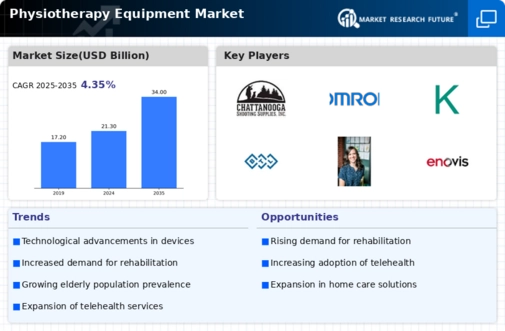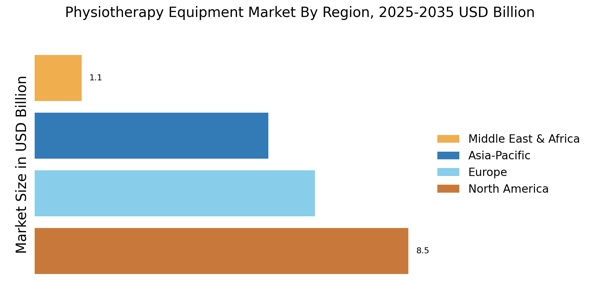Aging Population
The aging population is a critical factor influencing the Physiotherapy Equipment Market. As individuals age, they often experience a decline in physical health, leading to an increased need for physiotherapy services. The World Health Organization projects that the number of people aged 60 years and older will reach 2 billion by 2050, creating a substantial demand for rehabilitation equipment. This demographic shift is likely to drive the market for physiotherapy equipment, as older adults require specialized devices to aid in mobility and recovery from age-related ailments. Additionally, healthcare providers are increasingly focusing on geriatric rehabilitation, which may further stimulate the demand for innovative physiotherapy solutions tailored to this population. The intersection of an aging population and the need for effective rehabilitation strategies presents a significant opportunity for growth in the physiotherapy equipment sector.
Increased Health Awareness
There is a growing awareness of health and wellness among the general population, which is positively impacting the Physiotherapy Equipment Market. Individuals are increasingly recognizing the importance of physical therapy in maintaining overall health, preventing injuries, and enhancing quality of life. This heightened awareness is likely to lead to an increase in demand for physiotherapy services and, consequently, the equipment used in these therapies. Market Research Future indicates that the physiotherapy equipment sector is expected to witness a surge in sales as more people seek preventive care and rehabilitation solutions. Furthermore, fitness trends and the popularity of active lifestyles are encouraging individuals to invest in physiotherapy equipment for personal use, thereby expanding the market. This trend suggests a shift towards proactive health management, which could significantly benefit the physiotherapy equipment industry.
Technological Advancements
The Physiotherapy Equipment Market is experiencing a notable transformation due to rapid technological advancements. Innovations such as tele-rehabilitation, wearable devices, and advanced therapeutic modalities are reshaping treatment methodologies. For instance, the integration of artificial intelligence in physiotherapy equipment enhances personalized treatment plans, improving patient outcomes. The market for physiotherapy equipment is projected to grow at a compound annual growth rate of approximately 7.5% from 2025 to 2030, driven by these technological innovations. Furthermore, the adoption of virtual reality in rehabilitation programs is gaining traction, indicating a shift towards more engaging and effective therapeutic practices. As these technologies become more accessible, they are likely to expand the reach of physiotherapy services, thereby increasing demand for advanced equipment.
Government Initiatives and Funding
Government initiatives and funding play a pivotal role in shaping the Physiotherapy Equipment Market. Many governments are recognizing the importance of rehabilitation services in improving public health outcomes and are allocating resources to enhance physiotherapy infrastructure. Increased funding for healthcare facilities and rehabilitation programs is likely to drive the demand for advanced physiotherapy equipment. Additionally, public health campaigns aimed at promoting physical activity and rehabilitation are expected to further stimulate market growth. For instance, initiatives that encourage early intervention and preventive care can lead to a higher utilization of physiotherapy services, thereby increasing the need for specialized equipment. As governments continue to prioritize health and wellness, the physiotherapy equipment market is poised for expansion, supported by favorable policies and funding opportunities.
Rising Incidence of Musculoskeletal Disorders
The prevalence of musculoskeletal disorders is a significant driver for the Physiotherapy Equipment Market. Conditions such as arthritis, back pain, and sports injuries are becoming increasingly common, necessitating effective rehabilitation solutions. According to recent estimates, musculoskeletal disorders affect nearly 1.7 billion people worldwide, highlighting a substantial need for physiotherapy interventions. This growing patient population is likely to propel the demand for specialized physiotherapy equipment designed to address these conditions. As healthcare systems prioritize rehabilitation services, the market for physiotherapy equipment is expected to expand, with an emphasis on devices that facilitate recovery and enhance mobility. The increasing awareness of the importance of physical therapy in managing these disorders further supports the growth of this market.


















Leave a Comment